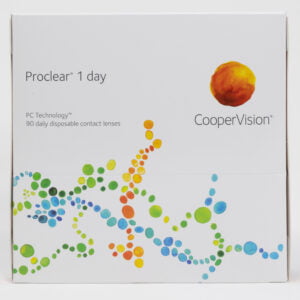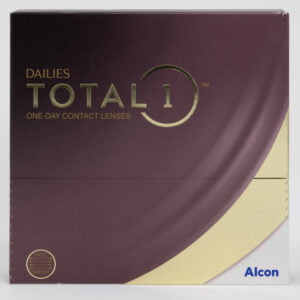Myopia (Nearsighted): Causes, Signs, & Treatment
What is Nearsightedness (Myopia)?
Myopia, also known as nearsightedness, is an optical condition of the eye that causes vision to be blurry when looking at things that are far away.
Therefore, myopia is also referred to as being nearsighted, as in, “I have near sight. I can see things that are near to me. I can’t see far away, but I can see up close, so I am nearsighted.”
If you struggle to see things clearly up close, that is referred to as hyperopia, or farsightedness.

Myopia Explained (Video)
How Common is Myopia?
Myopia is very common. According to the American Optometric Association, nearly 30% of the U.S. population is impacted by nearsightedness.
Symptoms and Signs of Having Myopia
When vision is not clear far away, that is a good indicator of myopia, also known as nearsightedness. However, myopia tends to slowly set in, making it less noticeable over time.
When myopia begins at a young age, children do not have anybody else’s eyes to compare with and do not realize what clear vision should be like, so they adapt to the changes in vision.
Therefore, some clues to watch out for are:
- Squinting
- Tilting
- Turning the head when focusing
- Complaints of not seeing the board in school
- Moving closer to the tv or objects to see them better
- Just not being impressed with the visual world around them
Is Myopia Dangerous?
No, myopia is not generally dangerous, even as it progresses.
Myopia does not make a person go blind over time. When the focal point of an eye moves off the fovea, it needs to be moved back to the fovea. The “power” of the prescription will increase, but the eye isn’t deteriorating.
However, in extreme cases of myopia, the overall length of the eye increases, which can stretch the retina and increase the risk of retinal detachment.
There is another condition (also associated with extreme myopia, but it should be considered separately because even extreme myopes do not always get it) called myopic degeneration that can cause the retina and overall vision to deteriorate over time.
What Causes Nearsightedness?
When the body grows, so does the eye. That is why children, especially during their greatest years of growth (8-16 years old) tend to have the greatest changes in their vision.
When light enters the eye, it is supposed to converge to focus at a pinpoint spot on the retina called the fovea. Sometimes, this precise focus of light on the fovea changes because of optical changes or length changes if the eye.
For example, imagine light is focused on the fovea where it is supposed to be, and then the eye grows longer. That would mean that light is no longer focused on the fovea, and instead is focused in front of the fovea. This imperfect focus creates blurry vision. The further the focus point is away from the fovea, the greater the blur.
Is Myopia Hereditary?
Yes, Myopia is hereditary. In fact, if both parents are myopic, then the odds are pretty strong that their children will be too.
How is Myopia Treated?
To treat nearsightedness, the off-point of focus needs to be moved back on to the fovea to create a clear focus. This is done by diverging the light, and pushing the point back onto the fovea.
Glasses and contacts are the two most common ways to move the point back to the fovea.
For example, if the point is 2.25 millimeters in front of the fovea, then the point needs to be moved backward 2.25 millimeters to establish clear focus. However, we wouldn’t use the terminology of “backward 2.25 millimeters”, instead, we would say “-2.25 Diopters Sphere (DS)”.
Light is not measured in units of length, it is measured in diopters. Since the point has to be moved backwards (therefore diverged), we would use the “-” symbol (read the “minus” symbol), and give glasses or contacts with the power of -2.25 DS.
Can Myopia be Prevented?
Since myopia is genetic, there isn’t anything that you can naturally do to make it appear or prevent it from coming.
There has always been speculation as to whether reading and computers cause myopia, but it has never been proven.
For example, you may prefer doing near activities, like reading and using digital devices, because they are easier to see than activities that require far vision. An onlooker may observe, “Look. All those kids reading and on the computer over there that are nearsighted. It must be the reading and computer that are causing nearsightedness.” However, “correlation is not causation”.
It should not be implied that kids that like to read and are nearsighted because of the reading. If it were true, then all of us who read might be nearsighted, right?
Popular Lenses Compatible with Nearsightedness
-
Product on sale
 ACUVUE® OASYS MAX 1-Day Multifocal (90 pack)Original price was: $181.50.$129.99Current price is: $129.99.
ACUVUE® OASYS MAX 1-Day Multifocal (90 pack)Original price was: $181.50.$129.99Current price is: $129.99. -
Product on sale
 Proclear 1-Day (90 pack)Original price was: $83.50.$74.99Current price is: $74.99.
Proclear 1-Day (90 pack)Original price was: $83.50.$74.99Current price is: $74.99. -
Product on sale
 Dailies Total1® (90 pack)Original price was: $130.05.$104.99Current price is: $104.99.
Dailies Total1® (90 pack)Original price was: $130.05.$104.99Current price is: $104.99.
Which Brand of Contact Lens Should be Used for Myopia?
All major contacts brands make lenses for myopia.
We recommend daily disposable for safety and simplicity if your budget allows, but what will ultimately determine your choice of brand will likely be your lifestyle and your discussion with your eye doctor.
Once you have your prescription, shop online with us for the top brands at the lowest prices with free delivery.
What is Myopia Management?
There is a current method of “myopia management” that can be given to children whose parent(s) have high levels of myopia if it seems that the child is following in their footsteps of eye growth.
The treatment implies that simply moving the focal point back to the fovea may correct vision, but may also encourage further growth of the eye. Therefore, myopic management relies on multifocals in both glasses and contacts and eyedrops during the growing years of the eye to reduce the overall length growth that the eye experiences.
However, even though studies suggest that myopia management has shown success, not all eye doctors employ its use.
Another form of myopia management practiced is called orthokeratology, which involves using rigid lenses designed to reshape the cornea of the eye at night to reduce the need for corrective lenses during the day.
Do Wearing Glasses or Contact Lenses Cause the Eye to Change more?
Wearing glasses or contacts doesn’t cause the eyes to get worse or better, they just move the focal point into position so the wearer can see again.
There is some supported belief that only correcting the focal point of light to the fovea without any further treatment encourages continued growth of the eyes of certain young individuals, but not all doctors embrace that practice.
Should I Get Glasses or Contacts for Myopia (Nearsightedness)?
If you have myopia (are nearsighted), then you should either wear only glasses or glasses in combination with contact lenses.
Contact lenses should not be worn exclusively, as they have inherent risks that can be avoided by letting the eye breathe. If you don’t have glasses, then you may not give your eye enough oxygen.
Contacts should always be worn along with the use of glasses. So, if you must get one or the other, get glasses first. Just know that you may have different prescriptions for contacts and glasses.
What are the Differences Between Glasses and Contact Lenses for Myopia (Nearsightedness)?
Glasses
Let’s talk about glasses first. With glasses, minus lenses create minification. In other words, when you look through the minus lenses of glasses, the world gets smaller.
| Fun Tip: You can tell if someone is nearsighted by looking at the size of their eyes when they have their glasses on. If their eyes look smaller, then they are wearing minus lenses, so they are nearsighted |
Therefore, when someone puts minus glasses lenses on for the first time, everything will be clearer, but the world will appear smaller too. When things look smaller, they also appear further away. New glasses wearers may experience this as disorienting and may even feel taller because the ground appears further away.
The more the glasses are worn, however, the faster this disorientation goes away. The brain will adapt with experience.
Contacts
In contact lenses, this minification does not occur because the contacts are worn directly on the eye. The main concern with contacts is the increased risk of infection and injury (which can be limited greatly with proper care and wear) that glasses do not cause.
Article Sources
American Optometric Association, Myopia (nearsightedness), https://www.aoa.org/healthy-eyes/eye-and-vision-conditions/myopia, Accessed November 15, 2022
Need Consistanly Cheap Contacts?
DeliverContacts.com always guarantees you are paying low prices, every time you buy. We will never play games with our pricing or take part in manipulative discounts. Just consistently cheap contacts, forever.
Give your box a search below and see for yourself! 100% Free shipping and returns on all products!



